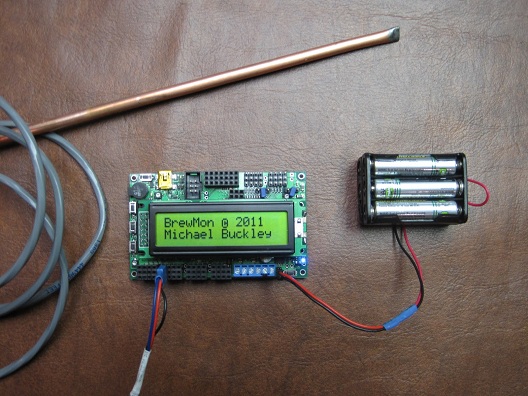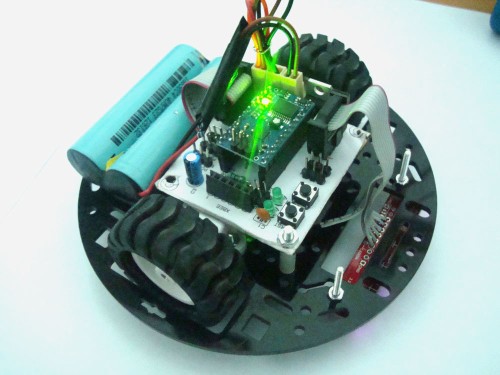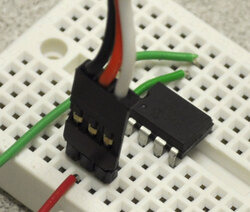Pololu Blog »
Pololu Blog (Page 90)
Welcome to the Pololu Blog, where we provide updates about what we and our customers are doing and thinking about. This blog used to be Pololu president Jan Malášek’s Engage Your Brain blog; you can view just those posts here.
Popular tags: community projects new products raspberry pi arduino more…
Waiter Robot
Waiter Robot can make a “Robot Bar” for your next exhibition, show, private event, or sales promotion. They use Pololu 3pi Robots to deliver food and drinks in an remarkable way. Update: The original site for this project is no longer accessible, so we have removed the link.
BrewMon: Orangutan SVP beer-brewing monitor
 |
A temperature probe, a battery pack, and a Pololu Orangutan SVP-324 Robot Controller are used to make BrewMon, a beer-brewing monitor.
Micromouse 3pi Robot Video
This video shows a heavily-modified 3pi that uses distance sensors and encoders along with a flood-fill algorithm to find the shortest path through a walled Micromouse maze. The robot is described in more detail in this forum post.
Simple microcontroller approach to controlling a servo
Today, I want to discuss the microcontroller equivalent of the simple servo control circuit I presented last time. As I mentioned then, the circuit is about as simple as it can be, yet it requires eight components to arrive at a sub-optimal servo control waveform. Some of its deficiencies, such as the slow rise time of the pulses, can be addressed by slightly more advanced circuits that might implement an astable multivibrator using an integrated circuit such as the famous 555 timer. In terms of part count, the 555-based servo controller might be a bit better than the two-transistor approach, but the 555 has many transistors inside it. As long as we are comfortable categorizing a component with many transistors inside it as a single part, we might as well skip the 555 and go straight to a low pin-count microcontroller, which has thousands of transistors inside it and which will allow us to make a far superior, single-component servo controller. Continued…
Build Yourself a Bluetooth Controlled Six-Legged Robot
This small hexapod using the Micro Maestro is controlled remotely using a Bluetooth module. Very detailed build information is available in this blog post.
Simple hardware approach to controlling a servo
For the last several posts, I have been writing about how hobby servos work and demonstrating the operation of devices made for controlling servos, such as RC receivers and serial servo controllers. That should have given you a good idea of the kinds of control signals we must create if we are to control servos with our own hardware. Today, I am moving on to the subject of controlling servos ourselves, and I will begin with a simple hardware approach. Continued…
Only5 - general-purpose, high-performance robot
 |
Only5 is designed to be a general-purpose, high-performance robot. It uses many Pololu parts including the Pololu 5" Robot Chassis RRC04A and the Baby Orangutan robot controller. For more information see the project page.
Here is a short video showing its impressive speed:
Instructable Groovin' Grover: a microcontroller-based marionette
Groovin’ Grover is a marionette manipulated by four hobby servos and a Pololu Maestro servo controller. You can control each of Grover’s limbs independently and make him walk, wave, and – most entertainingly – make him dance. Groovin’ Grover is easy to assemble and wire up. This Instructable explains how to build your own Groovin’ Grover.
Servo control interface in detail
Last time, I gave a basic introduction to the simple pulse interface for sending commands to servos. In this post, I want to explore some of the details and ramifications of the servo interface in a bit more depth. I’ll be using the Mini Maestro 12-channel servo controller, which offers a lot of servo control flexibility, and a current probe with my oscilloscope to illustrate servos’ responses. Continued…
Robot Zero: a fast line follower for beginners
This excellent guide from C.I.r.E. (Club de Informática, robótica y Electrónica) shows in detail how to build a fast (> 2 m/s) line-following robot from scratch, and it makes use of a number of Pololu products.





























